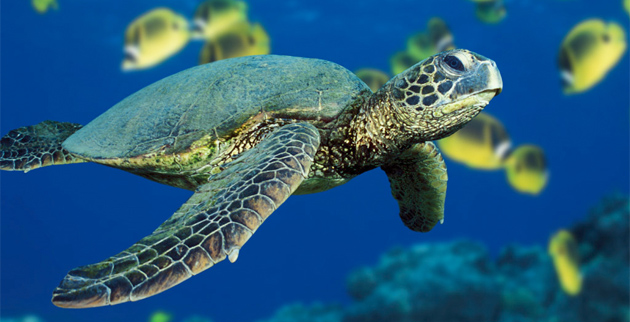Catching More Than Fish
A new study finds that millions of sea turtles may be victims of commercial fishing.

The number of sea turtles inadvertently caught by commercial fishing gear during the past 20 years may reach into the millions, according to the first peer-reviewed study to compile sea turtle bycatch data from gillnet, trawl and longline fisheries worldwide.
Six of the world’s seven species of sea turtles are currently listed as vulnerable, endangered or critically endangered on the International Union for Conservation of Nature (IUCN) Red List of Threatened Species.
Serious threat
“Fisheries’ bycatch—the unintentional capture of non-target species in fishing gear—is the most serious threat to sea turtle populations around the world,” said Rebecca Lewison, SDSU biology professor and lead principal investigator on the project.
“This study highlights vast ocean regions where little is known about bycatch rates, and where urgent conservation action to reduce bycatch is necessary to prevent the extinction of these ancient, endangered animals.”
The research was conducted as part of a multi-year initiative funded by the Gordon and Betty Moore Foundation led by Lewison and Larry Crowder at Duke University. Project GloBAL (Global Bycatch Assessment of Long-lived Species) was designed to characterize the bycatch of marine mammals, seabirds and sea turtles by synthesizing existing information and developing new analytical and quantitative tools to assess bycatch effects and risk.
The study, recently published in the journal Conservation Letters, analyzed data compiled from peer-reviewed papers, government reports, technical reports and symposia proceedings published between 1990 and 2008. All data were based on direct onboard observations or interviews with fishermen, but did not include data from recreational fishing.
““Loggerhead turtles die the same way in the Mediterranean, where boats from 21 countries hunt for tuna and swordfish. These two areas are urgent conservation priorities.””
Two areas to watch
Led by Lewison and Bryan Wallace, science advisor for the Sea Turtle Flagship Program at Conservation International, the team of researchers provided the first worldwide comparison of bycatch rates among regions. When they compared the impact of various kinds of fishing gear in different parts of the world, two areas stood out for their intense fishing and high rates of bycatch.
“In the eastern Pacific, endangered leatherbacks and other turtles get caught on hooks baited for tuna,” Lewison said.
“Loggerhead turtles die the same way in the Mediterranean, where boats from 21 countries hunt for tuna and swordfish. These two areas are urgent conservation priorities.”
Reducing bycatch
The research confirms what governments and resource managers in some countries already know: fisheries’ impacts are likely having a significant effect on turtle populations worldwide. While some countries have been working to reduce bycatch across all fleets, many nations have not responded to the crisis.
“In many regions, we have enough data to warrant immediate action,” Lewison said.
“Because of joint efforts between fishers and managers in many countries, bycatch mitigation devices and practices exist that can substantially reduce bycatch. What is needed now is widespread adoption and implementation of bycatch-reduction gear and fishing practices.”
Effective measures to reduce turtle bycatch include the use of circle hooks and fish bait in longline fisheries, and Turtle Excluder Devices (TEDs) in trawling. Other approaches, such as the creation of marine protected areas and use of catch shares, also help reduce bycatch.



